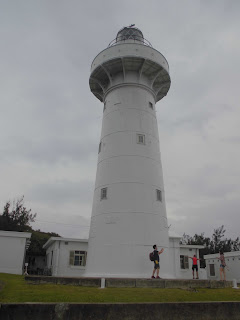灯台についてポストするのは長い間していないが、今日は久しぶりに灯台を紹介する。恆春の南方に墾丁国家公園がある。公園内に鵝鑾鼻灯台がある。(意外と日本語のウィキページはない。)この灯台は台湾島最南端の灯台で、1883年にできた。当時台湾はまだ清朝の植民地で、他の多くの清朝灯台と同じくイギリス人によって建てられた。(当時は満国(清朝)より、西洋の方がこういう技術が優れたから。)
当時この辺に住んでいたパイワン人は新しく移民してきた中国人に対して色々不満があって、時々襲ってきたりした。そのためこの灯台は砦の様に作られている。灯台としてはとても珍しい設計だ!
It's been a while since I posted a lighthouse on this blog, so I'm going to rectify that today. Hungchwun is way to the south, but even farther south is Kunding National Park(墾丁國家公園), which encompasses the whole southern peninsula of the island. In this park is a historic lighthouse, the Uhlwonbee Lighthouse(鵝鑾鼻燈塔). This lighthouse was built in 1883 when Taiwan was still a colony of the Ching Dynasty. Like many Ching Dynasty lighthouses, it was not actually built by the Manchurian government, but by an Englishman. There are quite a few English-built lighthouses on the coast of China, near the ports that were open to foreign trade and settlement during the Ching period.
Because the local Paiwanese people were not always friendly to outsiders traipsing around in their territory, the lighthouse was designed to also function as a fort; an unusual feature for a lighthouse.
玄関前の地面にこの可愛らしいタイルを見かけた。
Outside of the lighthouse, near the entrance (This is the only lighthouse I've been to in Taiwan where I was charged a fee to enter the grounds.) there were these animal tiles. I thought they were cute. You can also enjoy laughing at how unable I am to hold a camera straight. Seriously, what gives with me?
在燈塔停車場地上有這些可愛動物的瓷磚。
灯台だ!
Here it is!
到了!
"Uhlwonbee" The name of the lighthouse, and the cape that it's on.
砦と先ほど述べたが、この写真を見たらよく分かると思う。周りに塀があり、塀の外側はさらに溝になっている。そして塀のあちらこちらに大砲が出る様な穴が開いている。灯台守衛という仕事は普通、めっちゃ寂しくてつまらない様なイメージがあると思う、清朝時代の鵝鑾鼻灯台の守衛員はきっとそうじゃなかっただろう!
Here we can see how the whole thing is surrounded by a trench and these sloped walls. There are also some places where there are holes for cannons. Most lighthouse keepers back in the day would have had to contend with boredom and loneliness, but the keeper at this lighthouse would have been in the company of a contingent of soldiers, and would have experienced the exhilarating thrill of period raids by angry Paiwanese soldiers out for blood/heads.
因為建立燈塔當時住這邊的排灣人跟中國人的關係不太好,所以排灣人有時候會來攻擊。為了保護燈塔四周都有壕溝,圍牆,然後在牆上有大砲的槍眼。燈塔看守員這份工作一般來說算是蠻無聊,很寂寞的工作。不過清朝時代鵝鑾鼻燈塔的看守員旁邊一定會有一些軍人,有時候排灣的軍人會出現打一打仗。聽起來蠻有刺激性的工作!
"Uhlwonbee Lighthouse"
この日の天気はどうだったと思う?
Guess what the weather was like?
猜猜這天的天氣怎麼樣。
大砲の台かな?
Perhaps this is where the cannons were originally located?
大砲台?
銃眼(塀内から銃や大砲を撃つための窓口。)
A cannon hole in the surrounding wall.
大砲的槍眼
Education:
1948年の灯台
Here's the lighthouse in 1948.
1948年的照片。
確かこの旗は以前中華民国の海岸警備隊の旗だと思う。ちょっと忘れたけど。
Former flags for the Republic of China coast guard, or something like that. I forget.
以前海警局(?)的旗標。應該是海警局,可是我有一點忘記了。
近くにあった廟の天井
Magic turtle thing on a temple ceiling a little ways off from the lighthouse.
離燈塔很近的寺廟。
灯台を離れて、26号線を使って北上し、200号線に左折して山を越えて恆春に戻った。
After leaving the lighthouse, I drove up the peninsula on road 26, and then across 200 back to Hungchwun. The area was filled with scenes of pastoral beauty such as these.
離開燈塔之後先上26號再橫過200號回恆春。這邊人少田多,風景真的很漂亮。
途中に天然ガスが出る場所があった。
There was also this place where gas naturally seeps up from the ground. Once it catches fire, it stays going until the next heavy rain.
有一個地方天然的瓦斯漏出來。起火了,一直繼續燃燒到了下次大雨才滅火。
恆春に戻った。日本式の家があった。
And we're back in Hungchwun. I thought this old house was neat. It looks like a relic from the Japanese period.
回恆春來了!這棟房子看起來日式的。
次回、市塀をもっと紹介する。
More city walls next time.
下次再寫大門的話。










































No comments:
Post a Comment